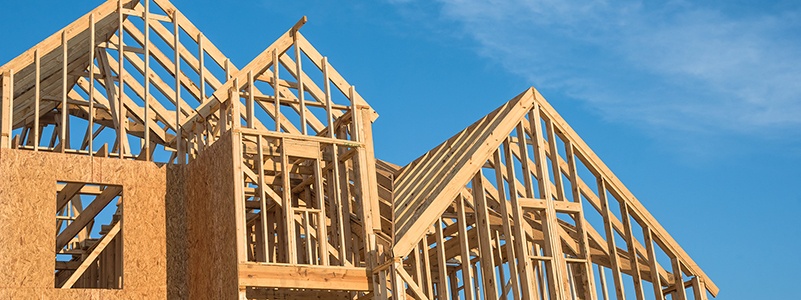
Building a house can take anywhere from six months to two years, based on a number of variables. Location, style, and size of the floorplan, weather, and even the region you live in will affect the amount of time it takes to complete the build.
While the thought of owning a brand new home built to your exact specifications no doubt sounds tantalizing in this hot seller’s market, it is important to know what you are potentially getting into and how long you could be waiting to move into your new house.
Knowing all the factors and the basic timeline at the outset will allow you to make an informed decision on whether a new home build is the right choice for you.

Average Time It Takes to Build a House
The average new home building process takes approximately seven to eight months, per the US Census Bureau.
This timeframe includes finalizing plans and obtaining permits, the actual construction of the home, and the final walkthrough. While it may seem tantalizingly short, bear in mind that these numbers largely apply to homes in new housing developments, where you can choose from a selection of floor plans and upgrade packages.
If you plan to build a fully custom home, you will need to factor in additional time to meet with the architect or builder and draw up plans, secure the necessary financing and permits, make all design decisions, and also build in a cushion for inevitable unforeseen delays or issues.
A typical custom-built home will take a little over a year from start to finish with a contractor, but for a fully custom home the process can potentially take multiple years.

Factors That Influence The Timeline
There are several common sources of delays that new home builds fall victim to. Some of them can be avoided or mitigated with proper planning, but some will simply have to be worked through.
Permits and Authorization
Depending on where you live, the process to obtain the necessary permits and approvals can be time-consuming.
Whether it is due to an overworked inspector, restrictions caused by local regulations, or just excessive paperwork that must be filed, delays at this stage are not uncommon. It is important to expect potential delays in this area and pad your timeline to account for them.
Location, Weather, and Environment
Where you choose to build your home will also affect the timeline. You may have found amazing views at your hill-top home site, but bear in mind that all materials and equipment needed to construct your dream home will also have to haul up that same hill, which could cause complications and delays.
During the preparation process, clearing and leveling the home site in preparation for the foundation could also run into delays, with the removal of trees, rocks, and other unknown debris.
Regionally, you will also see variables in the timetable, with builds in the northern regions taking longer on average than those in the south. This is most likely due to construction having to work around potential winter weather. Additionally, builds in urban and developed areas will be faster than those in rural areas or new developments that have not been established with utilities.
Inclement weather can also delay construction. In addition to halting work, storms can cause flooding, damage supplies, or make unpaved roads impassable for equipment.
Freezing weather and high winds can likewise necessitate the delay of some building steps. Curing the foundation, installing sheetrock, painting, roofing, and installation of sewer lines, among other steps, cannot be done during inclement weather. Although there is no way to plan for such events, it is important to be aware of the possibility of weather delays.
Availability of Subcontractors and Workers
During the busiest building time of the year, summer, it is common for subcontractors to be unavailable on schedule due to the number of jobs requesting their attention.
Many critical construction steps, from foundation and roofing to electric and plumbing, require licensed subcontractors who specialize in those fields. It may be necessary for construction to be temporarily delayed until they are available to complete the work needed.

Style and Scale of Your Home
It stands to reason that larger homes take longer to construct, and the same goes for more intricate designs. Building a truly custom home could experience unforeseen delays due to potential issues that come up throughout the process of building a floorplan that has not been built before.
If you are utilizing a floorplan provided by a builder, they will have constructed the same or similar homes before and will be better aware of, and able to plan for, any potential problems.
Homes with specialized materials could also potentially face delays if those materials are in shortage or are unavailable at the time they are needed.
Additionally, weather issues in the line of transit could lead to shipping delays or even damage to those materials in transit. Incorrect supplies delivered can also create timing headaches.
You
One of the biggest causes of delays in new construction is an indecisive buyer. Changing the plans halfway through a build, altering material choices, or waiting to make design decisions until the last minute can delay or even halt construction.
Some materials take weeks to arrive once you order, so if you wait until it’s time to install those materials to decide what you want, it will mean halting construction as you wait for them to arrive.

Average Time By Construction Type
As mentioned above, build times will vary depending on what type of new home build you choose and the level of customization involved. Generally speaking, more decisions on your part as the buyer will equal a longer build time.

Homes built for sale will be the fastest route. These are homes built in new subdivisions by a builder and are intended to be sold. The builder will be working off a set series of floorplans that their team has built many times before, eliminating time delays due to “unknowns”.
In a built-for-sale home, there may be a few customizations that you can have a say in, such as the kitchen counters or wall colors, but most of the decisions in these cookie-cutter style homes will already be made.
A contractor-built home is one where a landowner works with a contractor to design and build a custom home. Contractor-built homes provide a great deal more customization, which slows down the process but still affords the buyer a chance to work with an established team.
The most time-consuming option is to opt for an owner-built home, where you as the landowner act as the general contractor and oversee the entire project yourself.

A Typical Build Timeline
While each new home build will be unique, there is a general process of steps that have to happen for each build. We have outlined the basic process of building a home on a 20-week schedule as an example.
Most new home construction will take longer than 20 weeks and there are always unforeseen delays, but the process of events will be largely the same.
Week 1: Preparation and Groundbreaking
Before construction can begin, the homesite will need to be prepped. The site will be cleared of any obstructions, such as trees or rocks, and it will be leveled. The general outline of the home will be mapped out on the ground in preparation for the next step.
Week 2-5: Foundation and Framing
Once the site is prepped and leveled, it is time to start building the home. First, the footing, a concrete base that supports the foundation and entire structure of the home, will be poured and set. An inspection will be performed to ensure it is correct.
Next, the foundation will be added on top of the footing and anchored with anchor bolts. The foundation can be a slab, which is most common in Texas, or can include a crawl space or basement. Once the foundation has been poured, set, dried, and inspected, the construction will move on to the framing.
The framework will create the bones of the home, giving it structure and shape. The walls, floors, and roof will be framed up and covered in a protective barrier known as a house wrap. The structure will again be inspected to make sure this critical step was done properly.

Week 6-7: Mechanicals
Now that the bones of the home are completed, the mechanical elements can be added. This step will include electrical wiring, plumbing, and ventilation, as well as siding and roofing. The HVAC system and water heater will also be installed at this stage. Another inspection will be done to make sure all work is correct and up to code.
Week 7-8: Insulation and Drywall
Once all of the mechanical elements are in place, insulation and drywall will be added to the interior walls and they will be primed for painting. This is an exciting step for many buyers as the house truly starts to look like a house.
Week 9-11: Flooring and Paint
The next step will be to install hard flooring and paint the walls. Due to the possibility of soiling during the building process, carpet is usually installed later. Cabinets, molding, and trim will also be added at this stage.
Week 12-13: Exterior Finishes
Exterior finishes not already installed, including brick or stonework and siding will be added at this point.

Week 14: Interior Finishes
Expect a buzz of activity during this stage of the process, with electricians, plumbers, and other subcontractors installing interior fixtures and finishing touches throughout the home.
From light fixtures and faucets to countertops and appliances, the defining touches will be added. The bathrooms will take shape as the toilets, sinks, tubs, and showers are installed. Any carpeting will also be installed.
Week 15: Driveways and Walkways
Once all the large and heavy fixtures and appliances have been installed in the home, the exterior doors will be installed. By waiting until this stage, builders avoid the possibility of damaging the doors as they bring those items in. The driveway and walkways will also be added at this stage.
Week 16: Clean up
Construction naturally means mess. Now that all elements are in place in the home, clean-up will begin to prep the house for a final inspection. Dust and spills will be cleaned up and all trash and leftover items will be removed.

Week 17: Landscaping
The final step in making the house look like a home is to add landscaping. This may be as simple as laying down sod grass and planting a tree or a few shrubs. It could also entail a detailed landscaping design to compliment the exterior of your new home.
Week 18: Inspection
All new buildings must be inspected by a building code official to ensure there are no violations. After the inspector walks the home and determines it is free of errors, they will issue a certificate of occupancy, allowing the home to be inhabited.
Week 19: Final Walk-Through
At this stage, you will be given a tour of your home where you can inspect it to determine that it was completed to your specifications, that all fixtures and appliances are in working order, and that there is no damage or defects that need to be corrected before you move on to closing.
It is important to speak up during the walk-through if there is anything you need fixed or have concerns about so that they can be addressed before you take ownership.
Week 20: Closing
Once you are satisfied with the completed home, you will be able to schedule your closing. This will involve signing all final documents, finalizing financing, and receiving your keys.

Ways to Shorten The Build Time
While it will be impossible to avoid any and all delays, there are steps you can take to ensure your build doesn’t get hung up due to indecisiveness, disorganization, or lack of communication.
Way 1: Make a Plan and Stick to It
It is critical to approach a new home build with a clear plan in place and then stick to that plan moving forward. Whether you are working with a builder’s floorplan or designing your dream home from scratch, make sure you are setting realistic goals and expectations from the start.
First and foremost to establish at the beginning is budget. Securing financing in the form of a pre-approval will give you a concrete number to bear in mind when tempting new ideas come up during the course of the build. With a clear budget from the onset, it will be easier to stay on track.
Making any and all possible design choices early will also help prevent delays throughout the building process. Make as many decisions as you can before the groundbreaking begins, and resist the urge to make changes and upgrades as the process moves forward.

Way 2: Keep an Eye On the Schedule and Be Flexible
If you are more involved in the building process, have a clear picture of the expected schedule, and check in regularly with your contractor to ensure everything is proceeding in a timely manner. If delays do pop up, discuss how that time could be utilized doing other jobs or how the plans could be modified to stay on track. A change in chosen material, supplier, or subcontractor could keep the schedule intact.
Way 3: Maintain an Open Line of Communication
Communication is key in keeping a construction project moving forward. Regularly check in with your builder or contractor to discuss progress and any issues that pop up. Open communication means that problems can be dealt with promptly or even avoided altogether.
If you are doing an owner-built home and therefore are acting as the general contractor, make sure your architect, builder, and any subcontractors are in direct communication with each other as well, eliminating the possibility of miscommunication by acting as the middle man.

Is Building New Worth The Wait?
The short answer is that it depends on your situation. If you have the time to wait and have a little cushion in your budget, it could be a great option for you. If you need to be in your new home before the kids are back in school, this is probably not the best route to take.
There are many pros and cons to undertaking a new home build, but here are some of the most commonly considered.
Pros:
* You can build exactly the home you want, where you want it.
* You will have less initial maintenance as everything will be brand new.
* Most new homes are built with energy efficiency in mind and will be fully updated to the current trends.
* You do not have to compete with other buyers to secure this home.
Cons:
* Building a new home costs more than buying an existing home, and there can be unexpected additional costs along the way.
* Building a home is a serious time commitment and is known to be a stressful process.
* It will be a lot of work on your part, and the sheer number of decisions to be made can be overwhelming for some.
* Securing financing for construction loans is more complicated than a standard mortgage for a pre-existing home and they often have a higher interest rate.
There are definite advantages to building your own home, but the choice may not be right for everyone due to time and expense issues. It is important to weigh your goals and limitations honestly to determine if this the route you want to take.
Whether you want to build a home or buy an existing home, we would love to help you discuss your options and craft a plan to help you achieve your goals. Visit us today at homecity.com to get started.










